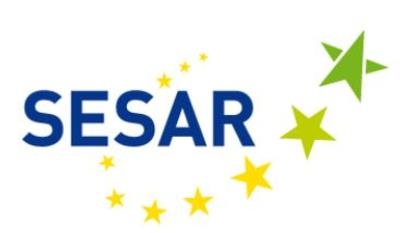Wed, Mar 09, 2016
European Collaboration Demonstrates Use Of Existing Satellite Communication Systems For Enhanced Air Traffic Management
SESAR members together with partners and the European Space Agency’s Iris Precursor have carried out a joint flight trial, successfully demonstrating that existing satellite technology systems are a viable option for air traffic services datalink. The trial showed for the first time how Iris Precursor technology can be used to provide end-to-end air–ground communications for initial ‘4D’ flight trajectory management, connecting aircraft and ATM ground systems to optimise the aircraft trajectory in four dimensions: latitude, longitude, altitude and time. The flight trial further confirms the benefits offered by i4D in terms of increased flight predictability and overall network efficiency.

Carried out by the members of the SESAR Joint Undertaking (SESAR JU), the flight trial represents an important milestone in the continued collaboration between satellite and ATM industries in Europe. The Iris Precursor is the denomination for datalink communications over the existing SwiftBroadband (SBB) satellite network from Inmarsat using the Aeronautical Telecommunication Network (ATN) as the standard protocol for the datalink services implementing rules.
“The flight trial shows what can be achieved by joining forces on European aviation modernisation. The results are clearly in line with the SESAR vision of the future ATM system, as captured by the European ATM Master Plan,” said Florian Guillermet, Executive Director of the SESAR JU.
The SESAR flight trial was performed on the 23 February 2016 on an Airbus A330 MSN871. The aircraft took off from Toulouse, flew over Baleares islands and came back to Toulouse passing above Madrid. During the flight, i4D Automatic Dependent Surveillance-Contract (ADS-C) reports and Controller Pilot Data Link Communication (CPDLC) exchanges were performed with the EUROCONTROL Maastricht Upper Area Control Center (MUAC). It showed how ADS-C contracts could be successfully maintained with two air traffic control centres (MUAC and Airbus Toulouse) for over two hours. During this time, i4D ADS-C reports were generated on event resulting in downlinking trajectory updates approximately every 20 seconds with 20 waypoints - an update rate which is well above the rate expected when initial 4D trajectory exchanges are implemented. In addition to the i4D trajectory exchanges, various CDPLC messages were exchanged along the flight with a remarkable performance rate round trip time of below two seconds throughout the
flight’s duration.
The flight trial also tested the handover between the Inmarsat satellite spot beams, which were completely transparent from the perspective of on-board the aircraft. In terms of connectivity, the trial experienced no loss or provider aborts, a frequent issue with the existing VDL2 terrestrial datalink. Datalink is a key enabler for the SESAR vision, in particular, to implement 4D trajectory-based operations. This flight trial demonstrates that with efficient data link services, flight plans can be continuously updated during a flight to maintain an optimal trajectory to destination, allowing air traffic control to offer better routings, sequence aircraft far in advance, and maximise airport and airspace capacity. It also confirms that the Iris Precursor services based on the Inmarsat legacy network can successfully complement the existing terrestrial VDL2 infrastructure.
By 2018, Iris Precursor is expected to support CPDLC in Europe and open the door to initial 4D trajectory management. In the longer term, Iris will evolve to support full 4D and operate in a highly secure multi-link environment with future terrestrial datalinks. The transition roadmap from Iris Precursor to the future communication infrastructure is currently being addressed by SESAR 2020 - the next wave of research and innovation activities by the SESAR JU - as well as by ESA and Inmarsat (Iris Service Evolution).
(Source: SESAR news release)
More News
Improvement Brings LSA to Poland, Germany, & Hungary Czech LSA manufacturer Direct Fly has given its low-wing, tricycle geared LSA an upgrade, with a bump to a max takeoff weig>[...]
Also: Midnight eVTOL Certification, Falcon 9 Record, Pro Line Fusion, Europa Clipper The warbird community celebrated Mark Novak, Chief Pilot of their B-29 'Doc', and his accomplis>[...]
From 2016 (YouTube Version): A VW Bug Engine Conversion Has Matured Into an Engine for the Airplane Homebuilder… While at EAA AirVenture 2016, ANN News Editor, Tom Patton, v>[...]
Large Heavy-Duty Deer Feed Bag Obstructed The Radiator Inlet And Restricted Its Designed Cooling Capability Analysis: Before departing on the local area flight in the experimental >[...]
The Project Looks Promising Enough for Procurement Already, but the Order isn't Firm Yet XTI Aerospace announced that Mesa Airlines has placed an investment-cum-order into their co>[...]
 ALTO NG Sees Increased Payload
ALTO NG Sees Increased Payload Airborne 05.30.24: High Time B29 Pilot, KLAL Teams With ACE, CHOPPER COPS
Airborne 05.30.24: High Time B29 Pilot, KLAL Teams With ACE, CHOPPER COPS Classic Aero-TV: Ralph Maloof Revs Up - Innovations For Homebuilt A/C Engines
Classic Aero-TV: Ralph Maloof Revs Up - Innovations For Homebuilt A/C Engines NTSB Final Report: Powrachute Pegasus
NTSB Final Report: Powrachute Pegasus Mesa Invests in TriFan 600
Mesa Invests in TriFan 600



